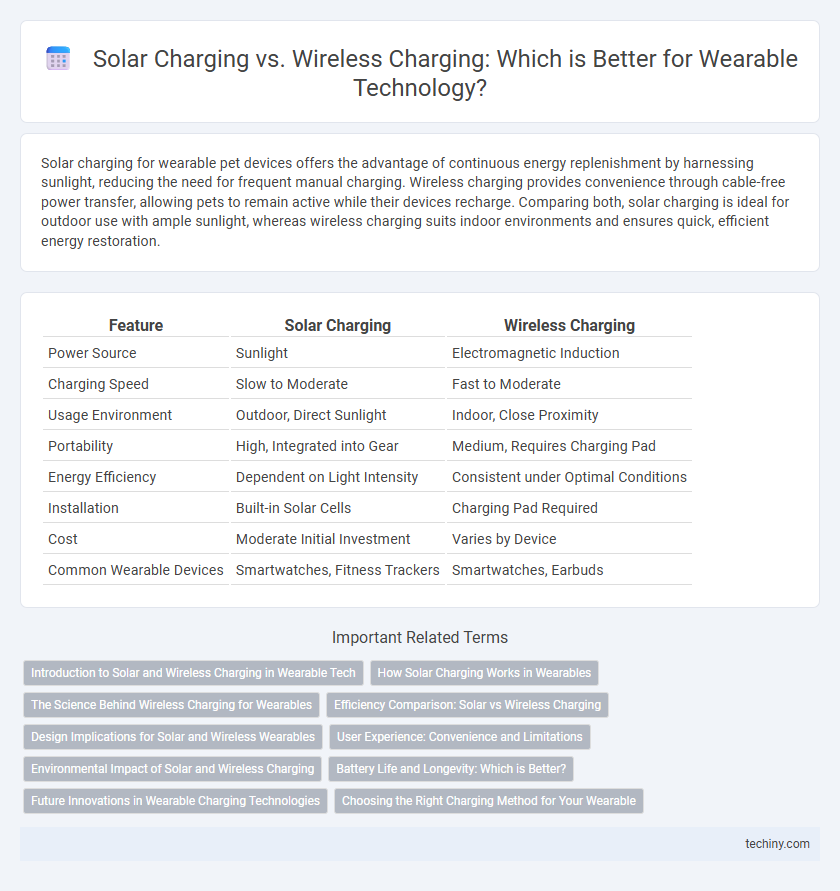Solar charging for wearable pet devices offers the advantage of continuous energy replenishment by harnessing sunlight, reducing the need for frequent manual charging. Wireless charging provides convenience through cable-free power transfer, allowing pets to remain active while their devices recharge. Comparing both, solar charging is ideal for outdoor use with ample sunlight, whereas wireless charging suits indoor environments and ensures quick, efficient energy restoration.
Table of Comparison
| Feature | Solar Charging | Wireless Charging |
|---|---|---|
| Power Source | Sunlight | Electromagnetic Induction |
| Charging Speed | Slow to Moderate | Fast to Moderate |
| Usage Environment | Outdoor, Direct Sunlight | Indoor, Close Proximity |
| Portability | High, Integrated into Gear | Medium, Requires Charging Pad |
| Energy Efficiency | Dependent on Light Intensity | Consistent under Optimal Conditions |
| Installation | Built-in Solar Cells | Charging Pad Required |
| Cost | Moderate Initial Investment | Varies by Device |
| Common Wearable Devices | Smartwatches, Fitness Trackers | Smartwatches, Earbuds |
Introduction to Solar and Wireless Charging in Wearable Tech
Solar charging in wearable technology harnesses photovoltaic cells integrated into devices to convert sunlight into electrical energy, offering a sustainable and portable power source. Wireless charging uses inductive coupling to transfer energy from a charging pad to the wearable device without physical connectors, enabling convenient and cable-free recharging. Both technologies aim to enhance user experience by extending device runtime and reducing dependency on traditional charging methods.
How Solar Charging Works in Wearables
Solar charging in wearable technology utilizes photovoltaic cells embedded into the device to convert sunlight directly into electrical energy, enabling continuous power generation during outdoor use. These solar cells are designed to be lightweight and flexible, seamlessly integrating into wearable fabrics or surfaces without compromising comfort or aesthetics. By harnessing ambient solar energy, wearables can extend battery life significantly, reducing the frequency of traditional charging and enhancing user convenience.
The Science Behind Wireless Charging for Wearables
Wireless charging for wearables operates through electromagnetic induction, where an alternating current in the charging pad generates a magnetic field that induces a current in the wearable device's receiver coil, efficiently transferring energy without physical connectors. This method relies on resonant inductive coupling, enabling energy transfer over short distances with minimal power loss, crucial for maintaining wearable battery health and convenience. Advances in coil design and frequency optimization enhance charging speed and alignment tolerance, making wireless charging a practical solution for continuous wearable device usage.
Efficiency Comparison: Solar vs Wireless Charging
Solar charging in wearable technology offers sustainable energy by converting sunlight directly into power, but its efficiency is heavily dependent on environmental factors like sunlight availability and intensity. Wireless charging provides a more consistent and faster energy transfer through electromagnetic fields, achieving efficiency rates typically between 70% and 90%, regardless of ambient conditions. Comparative studies show wireless charging outperforms solar methods in charging speed and reliability, while solar charging excels in off-grid scenarios where access to electrical power is limited.
Design Implications for Solar and Wireless Wearables
Solar charging in wearable technology demands integration of photovoltaic cells into device surfaces, influencing material choices and aesthetics to maximize light absorption without compromising comfort. Wireless charging requires precise alignment of coils and increases device thickness, affecting ergonomic design and portability. Designers must balance energy efficiency with user experience, optimizing form factors to accommodate distinct power sources while maintaining seamless wearability.
User Experience: Convenience and Limitations
Solar charging offers wearable technology users extended device autonomy by harnessing ambient sunlight, reducing reliance on power outlets and enhancing outdoor convenience. Wireless charging provides effortless power replenishment with simple device placement on charging pads, promoting seamless daily usage but requiring proximity and compatible surfaces. Both methods face limitations: solar charging depends on sufficient sunlight exposure, while wireless charging may generate heat and slow charging speeds, influencing overall user convenience.
Environmental Impact of Solar and Wireless Charging
Solar charging for wearable technology significantly reduces carbon emissions by harnessing renewable energy from sunlight, minimizing dependency on fossil fuels and decreasing electronic waste due to longer battery life. Wireless charging, while convenient, often results in higher energy loss during power transfer, leading to increased electricity consumption and a larger carbon footprint. Incorporating solar charging into wearables enhances sustainability by promoting energy efficiency and reducing environmental impact throughout the device lifecycle.
Battery Life and Longevity: Which is Better?
Solar charging extends wearable technology battery life by harnessing ambient sunlight, offering sustainable energy replenishment without frequent electrical plug-ins. Wireless charging provides rapid power top-ups but may contribute to faster battery degradation due to heat generation and repeated charge cycles. For maximizing battery longevity, solar charging offers a gentler and more eco-friendly solution, while wireless charging suits convenience with potential trade-offs in battery health.
Future Innovations in Wearable Charging Technologies
Solar charging in wearable technology harnesses ambient light through integrated photovoltaic cells, promising extended device autonomy without frequent electrical charges. Wireless charging advancements emphasize magnetic resonance and resonant inductive coupling, enabling more efficient energy transfer across greater distances and less precise alignment. Future innovations will likely combine hybrid systems that integrate solar harvesting with dynamic wireless charging capabilities, enhancing user convenience and sustainable energy use in wearables.
Choosing the Right Charging Method for Your Wearable
Selecting the optimal charging method for your wearable technology depends on usage patterns and convenience; solar charging offers sustainable energy by converting sunlight into power, making it ideal for outdoor enthusiasts and prolonged use without access to electricity. Wireless charging provides a fast, cable-free experience suitable for daily indoor wear, integrating seamlessly with rapid charging pads and smart home ecosystems. Evaluating factors like device compatibility, charging speed, and environmental conditions ensures efficient power management tailored to your wearable's capabilities.
Solar Charging vs Wireless Charging Infographic

 techiny.com
techiny.com